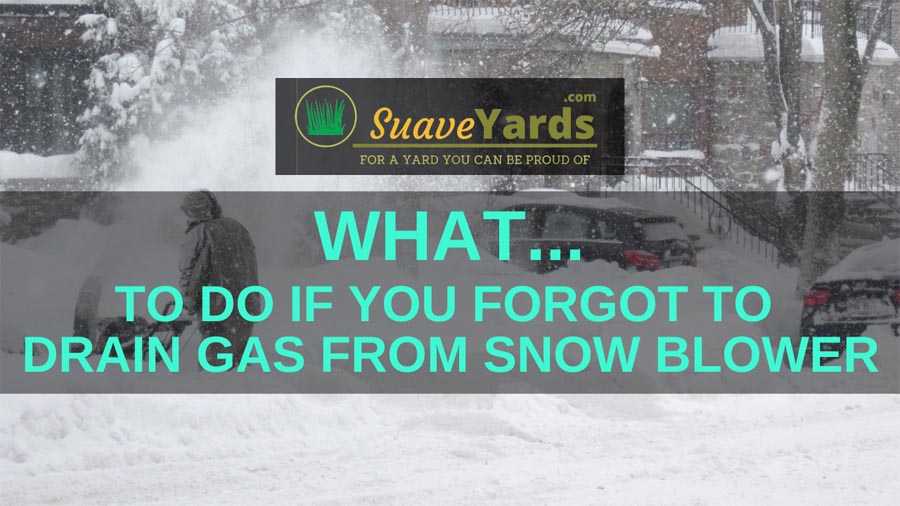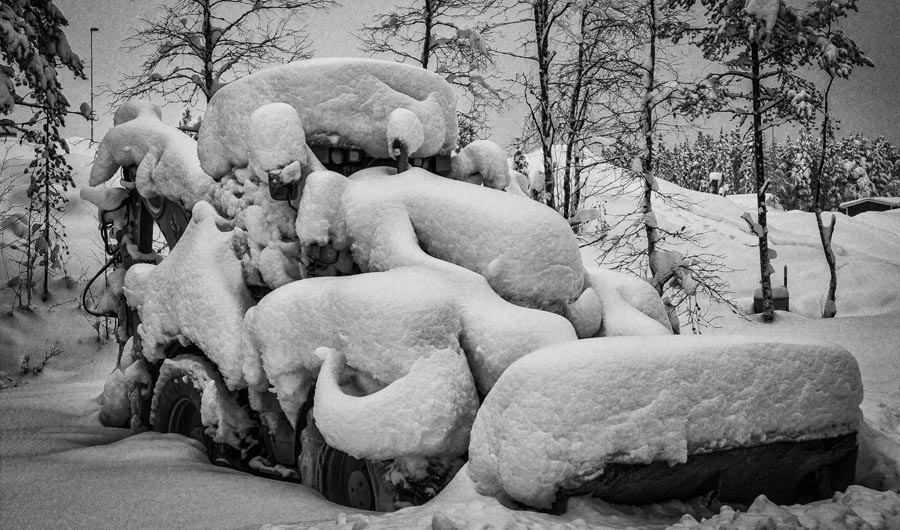
So you’ve just seen snow on the forecast for the first time this season and you start thinking about getting winter ready? And then you suddenly realize something…
You forgot to drain the gas from the snow blower after its final outing at the end of last winter!
It has been sitting there for the past eight or so months with old gas in it.
What damage has that done? Will it work? Should you even try and start it?
We examine all of that and more in this blog.
So let’s get started.
What Happens If I Forgot To Drain Gas From My Snow Blower?
If you forgot to drain gas from your snow blower and left it sitting over the summer you could well find the carburetor is clogged up. If it is, drain the gas and spray the carburetor with carb spray to clean it thoroughly and it should start. At worst you might need a carburetor rebuild or replacement.
The Problem With Leaving Gas in a Small Engine
So first things first, don’t panic!
The one important thing to note about leaving old gas in any small engine is that any damage to the engine itself will be minimal, if there is any at all.
The problem is for the carburetor.
The ethanol in regular gas attracts and absorbs moisture. That moisture is heavier than the fuel so sinks to the bottom of the tank.
Here it blocks up the carburetor and can make your snow blower either very difficult to start, or if it does start it most likely won’t run very well.
What You Should Do If You Have Left Gas in Your Snow Blower

So as I said if you have forgotten to drain the gas from your snow blower, don’t panic.
Even in a worst-case scenario, the situation is nearly always retrievable one way or another.
Initially try and start the snow blower.
If it starts and seems to run without any problems just drain the old gas and add some fresh gas with stabilizer mixed in.
Turn on your snow blower and run it for ten minutes to allow it to move through carburetor and fuel injection system.
Then keep a close eye on the carburetor for the season.
RELATED ===> Buyers Guide: The Best Snow Blowers on the Market
But let’s say your snow blower doesn’t start, or it does, but it is obvious it isn’t running properly.
Make sure you have some carb spray to hand and then follow these steps:
Step #1: Drain Gas and Clean the Carb
Drain all the gas from the tank and then drop the carburetor bowl to remove all the old gas from your blower. Make sure the air filter is removed as well.
Whilst all of the old fuel will have been removed, your carburetor jets will still be clogged.
Take your carb spray and spray the carburetor to within an inch of its life! Make sure you get it in all of the nooks and crannies and spray thoroughly inside the bowl.
Step #2: Put Everything Back Together
Put everything back together, except the air filter, and put completely fresh gas in the engine. Leaving the air filter off will create a vacuum that should pull fuel in.
Then try and start your snow blower.
If it is running fine, then job done. Put the air filter on and get to work.
If not, go to step three…
Step #3: Use Carb Spray and Repeat…
If it still doesn’t start spray some more carb spray into the throat of the carburetor, then try again.
Try this a few times and it should eventually run for a couple of seconds until the spray evaporates.
RELATED ===> How Much Gas Does A Snow Blower Hold?
Repeat the process and as it starts to die give another spray of the carb spray.
Keep repeating the process and with each attempt the engine should run a little longer until it eventually will stay running on its own.
If it doesn’t, then…
Step #4: Rebuild or Replace the Carburetor
If it still doesn’t start then it suggests there are serious problems with the carburetor and it needs to be either rebuilt or replaced.
Depending upon how confident you feel, you can try this yourself (use the video above if you need help), or take it to a mechanic to do it for you.
How Long Can Gas Sit In A Snow Blower?
Most manuals for small engines say that regular gas (which contains 10% ethanol) can sit unused in an engine for around 30 days before it starts to lose its volatility and goes stale.
Adding a stabilizer to regular gas will significantly increase its lifespan. Manufacturers of products such as STABIL say it will give the gas a shelf life of up to 24 months, but I would treat this with a bit of caution.
Non-ethanol fuel is much better for small engines as the lack of ethanol means it doesn’t attract moisture that can gunk up the carburetor.
I know many people who leave non-ethanol gas to sit in their mowers and blowers for five or six months without a problem.
Add Startron or STABIL to your non-ethanol fuel and it should keep good for this period without any problems.
Storing Your Snow Blower in the Off Season

There are actually two approaches when it comes to storing your snow blower when the winter has ended.
There is the run-it-dry approach and the leave-it-full approach.
Both have their pros and cons.
APPROACH #1: Leave It Full
Full means the whole system, tank, fuel lines and the carburetor.
The idea here is that leaving your snow blower with gas in it means all of the fuel lines and the carburetor stay fully saturated with gas as the gas never dries out.
This is opposed to running it dry, where no matter how hard you try there could always be some leftover gas that will dry out and causes sticky varnish.
On top of that some people believe that storing it dry could cause gaskets to dry out and crack.
Pros:
- Keeps everything lubricated.
- Keeps gaskets from drying out.
- Too much gas for it to evaporate and cause varnish.
Cons:
- In reality the gas can still dry out in places and cause varnish and gunk.
- Even with stabilizer in it, gas can still go bad after 8 or 9 months of no use and will need to be dumped.
RELATED ===> Should You Store Your Snow Blower With Or Without Gas?
APPROACH #2: Run It Dry
This means draining the fuel and running it until the engine stalls so you know it is empty.
The thinking behind this is that there is no gas to cause varnish and gumming of the carburetor.
Pros:
- No gas in the machine to dry up and clog carburetor.
- Can just leave machine for the season and forget about it.
- Can just put fresh gas in and start your snow blower up the next season.
Cons:
- Getting ‘all’ of the gas out is very difficult and involves draining the tank, disconnecting the line to the carb, removing the carb, leaving gas lines loose, etc. Even then there might be some gas left that can dry and cause problems.
- There is a miniscule chance the gaskets can dry out and crack.
I prefer approach two, but there is no right or wrong answer, either way is probably fine.
I just think even when adding stabilizer it is still difficult to keep gas in good condition for a long period of time.
Either way is better than just leaving a half-full snow blower in storage for most of the year though!
Final Thoughts

So you’ve forgotten to drain the gas from your snow blower and left it sitting all summer?
Don’t worry too much.
If you follow the steps we have laid out here you should be able to make sure it is running reliably for the winter.
At the worst you might have to rebuild or replace the carburetor, but there shouldn’t be any long-term damage to the engine.
It is important to remember to store your snow blower properly in the summer months.
You can either run it dry or leave it full of gas, both have their plus and minuses.
But as long as you store it properly it should be good to go again the following winter.
